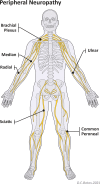Musculoskeletal Manifestations of COVID-19: Currently Described Clinical Symptoms and Multimodality Imaging Findings
- PMID: 35867593
- PMCID: PMC9341171
- DOI: 10.1148/rg.220036
Musculoskeletal Manifestations of COVID-19: Currently Described Clinical Symptoms and Multimodality Imaging Findings
Abstract
COVID-19, the clinical syndrome produced by infection with SARS-CoV-2, can result in multisystem organ dysfunction, including respiratory failure and hypercoagulability, which can lead to critical illness and death. Musculoskeletal (MSK) manifestations of COVID-19 are common but have been relatively underreported, possibly because of the severity of manifestations in other organ systems. Additionally, patients who have undergone sedation and who are critically ill are often unable to alert clinicians of their MSK symptoms. Furthermore, some therapeutic measures such as medications and vaccinations can worsen existing MSK symptoms or cause additional symptoms. Symptoms may persist or occur months after the initial infection, known as post-COVID condition or long COVID. As the global experience with COVID-19 and the vaccination effort increases, certain patterns of MSK disease involving the bones, muscles, peripheral nerves, blood vessels, and joints have emerged, many of which are likely related to a hyperinflammatory host response, prothrombotic state, or therapeutic efforts rather than direct viral toxicity. Imaging findings for various COVID-19-related MSK pathologic conditions across a variety of modalities are being recognized, which can be helpful for diagnosis, treatment guidance, and follow-up. The online slide presentation from the RSNA Annual Meeting is available for this article. ©RSNA, 2022.
Conflict of interest statement
Figures





















References
-
- Johns Hopkins University . COVID-19 Dashboard. Johns Hopkins Coronavirus Resource Center. https://coronavirus.jhu.edu/map. Accessed May 13, 2022.
-
- Tuzun S , Keles A , Okutan D , Yildiran T , Palamar D . Assessment of musculoskeletal pain, fatigue and grip strength in hospitalized patients with COVID-19. Eur J Phys Rehabil Med 2021; 57( 4):653–662. - PubMed
MeSH terms
LinkOut - more resources
Full Text Sources
Medical
Research Materials
Miscellaneous

